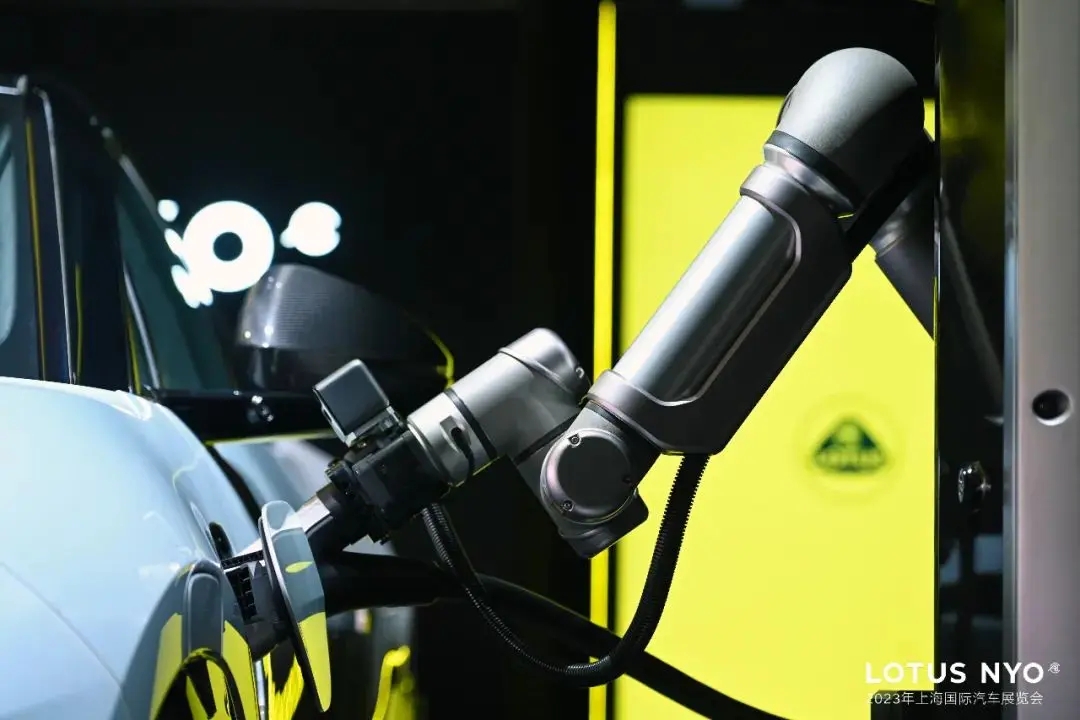The development of new energy vehicles is in full swing, and the issue of energy replenishment has also become one of the issues that the industry is fully concerned about. When people are debating the superiority and inferiority of overcharging and battery swapping, is there still a "Plan C" for charging new energy vehicles?
Perhaps influenced by the wireless charging of smartphones, wireless charging of cars has also become one of the technologies that engineers have conquered. According to media reports, recently, breakthrough research was conducted on wireless charging technology for cars. A research and development team claimed that wireless charging boards can transmit electricity to cars with an output power of 100kW, and can increase the battery charging state by 50% in 20 minutes.

Image source: Volvo Cars
Of course, wireless charging technology for cars is not a new technology. With the rise of new energy vehicles, various forces have been exploring wireless charging for a long time, including BBA, Volvo, and various domestic car companies.
Overall, wireless charging technology for automobiles is still in its early stages, and many local governments are exploring greater possibilities for future transportation. However, due to factors such as cost, power, and infrastructure, the large-scale commercialization of wireless charging technology for automobiles still needs to overcome multiple difficulties. The new story about wireless charging for cars is not yet easy to tell.
Charging power remains a hurdle
As is well known, wireless charging is not a new thing in the mobile phone industry. Wireless car charging is not as popular as mobile phone charging, but it has already attracted many companies to covet this technology.
Overall, there are four mainstream ways of wireless charging: electromagnetic induction, magnetic resonance, electric field coupling, and radio waves. Among them, mobile phones and electric vehicles mainly use two methods: electromagnetic induction and magnetic resonance.
Among them, electromagnetic induction wireless charging utilizes the electromagnetic induction principle of electric magnetism and magnetic electricity, with high charging efficiency but short effective charging distance, and strict requirements for charging location. Relatively speaking, magnetic resonance wireless charging requires lower positioning requirements and longer charging distances, which can support several centimeters to several meters, but the charging efficiency is slightly inferior to the former.
Therefore, in the early stages of exploring wireless charging technology, car companies favored electromagnetic induction wireless charging technology, with representative companies such as BMW and Daimler. Subsequently, magnetic resonance wireless charging technology gradually gained popularity, with representative companies including system suppliers such as Qualcomm and WiTricity.
As early as July 2014, BMW and Daimler (now Mercedes Benz) announced a cooperation agreement to jointly develop wireless charging technology for electric vehicles. In 2018, BMW began producing wireless charging systems as an optional device for the 5 Series plug-in hybrid model. Its rated charging power is 3.2kW, with an energy conversion efficiency of 85%, and it can be fully charged in 3.5 hours.
In 2021, Volvo launched wireless charging experiments using XC40 pure electric taxis in Sweden. Volvo has set up multiple test zones specifically in the city of Gothenburg, Sweden. Charging vehicles only need to park on wireless charging devices embedded in the road to automatically start the charging function. Volvo stated that its wireless charging power can reach 40kW, and it can travel 100 kilometers within 30 minutes of charging.

In the field of wireless charging for automobiles, China has also been at the forefront of the industry. In 2015, Southern Power Grid Guangxi Electric Power Research Institute completed the first wireless charging test lane for electric vehicles in China. In 2018, SAIC Roewe launched its first pure electric vehicle that achieved wireless charging. FAW Hongqi launched the Hongqi E-HS9 in 2020, which supports wireless charging technology. In March 2023, SAIC Smart officially launched its first 11kW high-power vehicle intelligent wireless charging solution.
Tesla is also one of the explorers in the field of wireless charging. In June 2023, Tesla acquired Wiferion for $76 million and renamed it Tesla Engineering Germany GmbH, aiming to leverage wireless charging in a low-cost manner. Previously, Tesla CEO Elon Musk held a negative attitude towards wireless charging and criticized it as "low-energy and inefficient". Now, he also claims that its prospects are broad.
Of course, many car companies such as Toyota, Honda, Nissan, and General Motors are also developing wireless charging technology.
Although various parties have made long-term explorations in the field of wireless charging, the technology of wireless charging for automobiles is still far from mature, and the key factor restricting its development is power. Taking the Hongqi E-HS9 as an example, its wireless charging technology has a maximum output power of 10kW, which is only slightly higher than the 7kW power of the slow charging pile, while some models can only achieve a system charging power of 3.2kW. That is to say, such charging efficiency has no convenience at all.
Of course, if the power of wireless charging is increased, it may be another situation. For example, as stated at the beginning of the article, a research and development team has achieved an output power of 100kW, which means that if such an output power can be truly achieved, theoretically the vehicle can be fully charged in about an hour. Although it is still difficult to compare with overcharged piles, it is still a new option for energy supplementation.
How far away is the commercialization of wireless charging?
From the perspective of usage scenarios, the biggest advantage of wireless car charging technology is the reduction of manual operation steps. Compared to wired charging, car owners need to perform a series of operations such as parking, getting off the car, retrieving a gun, and inserting charging. When facing third-party charging stations, they also need to fill in various information, which is relatively cumbersome.
The scenario of wireless charging is very simple. After the driver stops the vehicle, the device automatically senses and then performs wireless charging. After the vehicle is fully charged, the vehicle directly leaves without the need for further operations by the owner. From the perspective of user experience, it will also give people a sense of luxury when using electric vehicles.
Why has wireless charging for cars become highly valued by enterprises and suppliers? From a development perspective, the arrival of the era of autonomous driving may also be a time of great development in wireless charging technology. To truly achieve autonomous driving in cars, wireless charging is a form of charging that breaks free from the constraints of charging cables.
Therefore, many charging suppliers are very optimistic about the development prospects of wireless charging technology. German giant Siemens predicts that by 2028, the wireless charging market for electric vehicles in Europe and North America will reach $2 billion. As early as June 2022, Siemens invested $25 million to acquire a minority stake in wireless charging supplier WiTricity, promoting the technological research and development of wireless charging systems.
Siemens believes that wireless charging for electric vehicles will become mainstream in the future. In addition to making charging more convenient, wireless charging is also one of the necessary conditions for achieving autonomous driving. If you really want to launch autonomous vehicle on a large scale, wireless charging technology is indispensable. This is an important step towards entering the world of autonomous driving.
Of course, the prospects are beautiful, but the reality is bone deep. Currently, the energy replenishment methods for electric vehicles are becoming increasingly diverse, and the prospect of wireless charging is highly anticipated. However, from the current perspective, wireless charging technology for automobiles is still in the testing stage and faces many problems, such as high cost, slow charging, inconsistent standards, and slow commercialization progress.
The issue of charging efficiency is one of the obstacles. For example, we discussed efficiency issues in the aforementioned Hongqi E-HS9, which has been criticized for its low efficiency in wireless charging. At present, the efficiency of wireless charging for electric vehicles is lower than that of wired charging due to energy loss during wireless transmission.
From a cost perspective, further pressure is needed on wireless charging for cars. Wireless charging has high requirements for infrastructure, and charging components are generally laid on the ground, which will involve ground renovation and other issues. The construction cost will inevitably be higher than the cost of ordinary charging piles. In addition, in the early stage of promotion, wireless charging technology has an immature industrial chain, and the cost of related components will also be high, even several times the price of household AC charging piles under the same power.
For example, British bus operator FirstBus has considered using wireless charging technology in the process of promoting fleet electrification. However, after investigation, it was found that each ground charging board supplier quoted £ 70000. In addition, the construction cost of wireless charging roads is also high. For example, the cost of a 1.6 kilometer wireless charging road in Sweden is approximately 12.5 million US dollars.
Of course, safety issues may also be one of the constraints on wireless charging technology. From the perspective of its impact on the human body, wireless charging is not a major obstacle. The Provisional Regulations on Radio Management of Wireless Charging (Power Transmission) Equipment (Draft for Comments) released by the Ministry of Industry and Information Technology indicate that the frequency spectrum of 19-21kHz and 79-90kHz is dedicated to wireless charging vehicles. Related studies have shown that only when the charging power exceeds 20kW and the human body comes into close contact with the charging base, it may have a certain impact on the body. However, this also requires continuous safety promotion from all parties in order to gain consumer recognition.
Regardless of the practicality and convenience of wireless charging technology for automobiles, there is still a long way to go to achieve large-scale commercial use. Stepping out of the laboratory and implementing it in real-life situations, the wireless charging channel for cars is obstructed and long.
Charging robots, perhaps even better
As various parties are vigorously exploring wireless charging technology for automobiles, the concept of "charging robots" has quietly emerged. The pain point that wireless charging needs to solve is the issue of user charging convenience, which will complement the concept of autonomous driving in the future. However, there is more than one road to Rome.
Therefore, "charging robots" have also become a supplement in the intelligent charging process of automobiles. Not long ago, the Beijing Urban Sub center built a new power system experimental base for the National Green Development Demonstration Zone, and launched a fully automatic charging robot for public transportation, which can charge electric buses.
After the electric bus enters the charging station, the visual system captures the vehicle's location information, and the backend scheduling system immediately issues charging tasks to the robot. With the assistance of the pathfinding system and walking mechanism, the robot automatically travels to the charging station, grabs the charging gun, uses visual positioning technology to identify the position of the electric vehicle's charging port, and performs automatic charging operations.

Of course, car companies are also beginning to see the advantages of "charging robots". At the 2023 Shanghai Auto Show, Lotus unveiled a flash charging robot. When the vehicle needs to be charged, the robot can extend its robotic arm and automatically insert the charging gun into the vehicle's charging hole. After the charging is completed, it can also pull out the gun on its own, completing the entire process of starting and charging the vehicle.
In contrast, charging robots not only have the convenience of wireless charging, but also can solve the power limitation problem of wireless charging. Users can also enjoy the pleasure of overcharging without getting off the car. Of course, charging robots also involve cost and intelligent issues such as positioning and obstacle avoidance.
Summary: The issue of supplementing energy for new energy vehicles has always been a highly valued issue by all sectors of the industry. Currently, overcharging and battery swapping are the two most mainstream solutions. In theory, achieving a certain degree of these two solutions is sufficient to meet the user's energy replenishment needs. Of course, things always move forward, and perhaps with the arrival of the era of autonomous driving, wireless charging and charging robots may usher in new opportunities and tell new stories.
AMS2024 Exhibition Guide | Comprehensive Exhibition Guide, Don't Miss the Exciting Events Online and Offline
Notice on Holding the Rui'an Promotion Conference for the 2025 China (Rui'an) International Automobile and Motorcycle Parts Exhibition
On September 5th, we invite you to join us at the Wenzhou Auto Parts Exhibition on a journey to trace the origin of the Auto Parts City, as per the invitation from the purchaser!
Hot Booking | AAPEX 2024- Professional Exhibition Channel for Entering the North American Auto Parts Market
The wind is just right, Qianchuan Hui! Looking forward to working with you at the 2024 Wenzhou Auto Parts Exhibition and composing a new chapter!
Live up to Shaohua | Wenzhou Auto Parts Exhibition, these wonderful moments are worth remembering!
Free support line!
Email Support!
Working Days/Hours!





